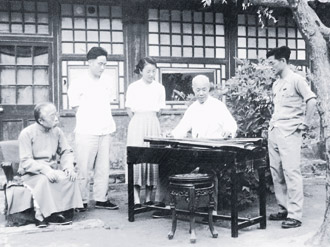Prince Fu on:
[Wikipedia]
[Google]
[Amazon]
 Prince Fu of the Second Rank, or simply Prince Fu, was the title of a princely peerage used in China during the
Prince Fu of the Second Rank, or simply Prince Fu, was the title of a princely peerage used in China during the
 Prince Fu of the Second Rank, or simply Prince Fu, was the title of a princely peerage used in China during the
Prince Fu of the Second Rank, or simply Prince Fu, was the title of a princely peerage used in China during the Manchu
The Manchus (; ) are a Tungusic East Asian ethnic group native to Manchuria in Northeast Asia. They are an officially recognized ethnic minority in China and the people from whom Manchuria derives its name. The Later Jin (1616–1636) and ...
-led Qing dynasty
The Qing dynasty ( ), officially the Great Qing,, was a Manchu-led imperial dynasty of China and the last orthodox dynasty in Chinese history. It emerged from the Later Jin dynasty founded by the Jianzhou Jurchens, a Tungusic-speak ...
(1636–1912). As the Prince Fu peerage was not awarded "iron-cap" status, this meant that each successive bearer of the title would normally start off with a title downgraded by one rank ''vis-à-vis'' that held by his predecessor. However, the title would generally not be downgraded to any lower than a ''feng'en fuguo gong'' except under special circumstances.
The first bearer of the title was Yihui (奕譓; 1845–1877), the Daoguang Emperor
The Daoguang Emperor (; 16 September 1782 – 26 February 1850), also known by his temple name Emperor Xuanxong of Qing, born Mianning, was the seventh Emperor of the Qing dynasty, and the sixth Qing emperor to rule over China proper, reigning ...
's ninth son, who was granted the title "Prince Fu of the Second Rank" by his father in 1850. The title was passed down over three generations and held by four persons.
Members of the Prince Fu peerage
* Yihui (奕譓; 15 Nov 1845 – 22 Mar 1877; 1st), theDaoguang Emperor
The Daoguang Emperor (; 16 September 1782 – 26 February 1850), also known by his temple name Emperor Xuanxong of Qing, born Mianning, was the seventh Emperor of the Qing dynasty, and the sixth Qing emperor to rule over China proper, reigning ...
's ninth son, held the title Prince Fu of the Second Rank from 1850 to 1877, posthumously honoured as Prince Fu Jing of the Second Rank (孚敬郡王)
**(a) Zaipei (載沛; 31 Mar 1872 – 23 Aug 1878; 2nd), initially named Zaihuang (載煌), Yidong's (a member from Prince Yu (愉)
Prince Yu of the Second Rank, or simply Prince Yu, was the title of a princely peerage used in China during the Manchu-led Qing dynasty (1636–1912). As the Prince Yu peerage was not awarded "iron-cap" status, this meant that each successive be ...
) sixth son and Yihui's adopted son, succeeded Yihui in 1877 as a ''beile''
**(a) Zaishu (載澍; 8 Nov 1870 – after 1909; 3rd), initially named Zaiji (載楫), Yizhan's (a member from Prince Zhi (直)) son and Yihui's adopted son, held the title of a ''beile'' from 1878 to 1897, his title stripped in 1897. His consort was 3rd daughter of Zhaoxiang, a younger brother of Empress Dowager Cixi
Empress Dowager Cixi ( ; mnc, Tsysi taiheo; formerly Romanization of Chinese, romanised as Empress Dowager T'zu-hsi; 29 November 1835 – 15 November 1908), of the Manchu people, Manchu Nara (clan)#Yehe Nara, Yehe Nara clan, was a Chinese nob ...
. He had two daughters.
**N/A
***(a) Pujin (溥伒; 30 Aug 1893 – 1966; 4th), Zaiying's (a member from Prince Dun
Prince Dun of the First Rank, or simply Prince Dun, was the title of a princely peerage used in China during the Manchu-led Qing dynasty (1636–1912). As the Prince Dun peerage was not awarded "iron-cap" status, this meant that each successive ...
) eldest son and Yihui's adopted grandson, held the title of a ''beizi'' from 1897 to 1945. He was missing with his daughter during Cultural Revolution
The Cultural Revolution, formally known as the Great Proletarian Cultural Revolution, was a sociopolitical movement in the People's Republic of China (PRC) launched by Mao Zedong in 1966, and lasting until his death in 1976. Its stated goal ...
.
****1 & 2 Yuquan (毓㟫) & Yuyan (毓巘)
Family tree
Legend: * - Title bearers * - EmperorsSee also
*Royal and noble ranks of the Qing dynasty
The Qing dynasty (1636–1912) of China developed a complicated peerage system for royal and noble ranks.
Rule of inheritance
In principle, titles were downgraded one grade for each generation of inheritance.
* Direct imperial princes with ...
* Prince Dun
Prince Dun of the First Rank, or simply Prince Dun, was the title of a princely peerage used in China during the Manchu-led Qing dynasty (1636–1912). As the Prince Dun peerage was not awarded "iron-cap" status, this meant that each successive ...
* Prince Zhi (直)
* Prince Yu (愉)
Prince Yu of the Second Rank, or simply Prince Yu, was the title of a princely peerage used in China during the Manchu-led Qing dynasty (1636–1912). As the Prince Yu peerage was not awarded "iron-cap" status, this meant that each successive be ...
References
* {{DEFAULTSORT:Fu, Prince Qing dynasty princely peerages